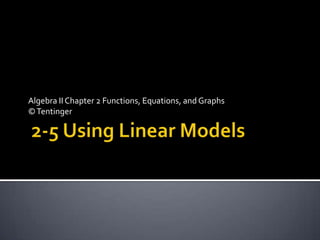Alg II 2-5 Linear Models
•Descargar como PPTX, PDF•
0 recomendaciones•329 vistas
Denunciar
Compartir
Denunciar
Compartir

Recomendados
Más contenido relacionado
La actualidad más candente
La actualidad más candente (20)
Exploiting Big Data in Time Series Forecasting: A Cross-Sectional Approach

Exploiting Big Data in Time Series Forecasting: A Cross-Sectional Approach
Forecasting Stock Market using Multiple Linear Regression

Forecasting Stock Market using Multiple Linear Regression
About the size and frequency of prime gapsMaximum prime gaps

About the size and frequency of prime gapsMaximum prime gaps
Econometrics notes (Introduction, Simple Linear regression, Multiple linear r...

Econometrics notes (Introduction, Simple Linear regression, Multiple linear r...
Destacado
Destacado (9)
Alg II Unit 4-8 Quadratic Equations and Complex Numbers

Alg II Unit 4-8 Quadratic Equations and Complex Numbers
Similar a Alg II 2-5 Linear Models
Similar a Alg II 2-5 Linear Models (20)
ECON 3406 Multiple Regression InstructionsLO2.2In this ass.docx

ECON 3406 Multiple Regression InstructionsLO2.2In this ass.docx
Measures and Strengths of AssociationRemember that while w.docx

Measures and Strengths of AssociationRemember that while w.docx
Exploring Support Vector Regression - Signals and Systems Project

Exploring Support Vector Regression - Signals and Systems Project
Convenience shoppingSTAT-S301Fall 2019Question Set 1.docx

Convenience shoppingSTAT-S301Fall 2019Question Set 1.docx
1 P a g e ME 350 Project 2 Posted February 26.docx

1 P a g e ME 350 Project 2 Posted February 26.docx
Más de jtentinger
Más de jtentinger (20)
Alg II 2-5 Linear Models
- 1. Algebra II Chapter 2 Functions, Equations, and Graphs © Tentinger
- 2. Essential Understanding: Sometimes it is possible to model data from a real-world situation with a linear equation. You can then use the equation to draw conclusions about the situation. Objectives: Students will be able to write linear equations that model real world data make predictions from linear models of data define and identify various types of correlation
- 3. Algebra A-CED.2. Create equations in two or more variables to represent relationships between quantities; graph equations on coordinate axes with labels and scales. Functions F-IF.4. For a function that models a relationship between two quantities, interpret key features of graphs and tables in terms of the quantities, and sketch graphs showing key features given a verbal description of the relationship★ F-IF.6. Calculate and interpret the average rate of change of a function (presented symbolically or as a table) over a specified interval. Estimate the rate of change from a graph.★ F-BF.1. Write a function that describes a relationship between two quantities.★
- 4. What is a scatter plot? A graph that relates two sets of data by plotting the data as ordered pairs. Can be used to determine strength of a relationship. The closer the points fall together the stronger the correlation(Correlation does not mean causation)
- 5. 5 basic types of correlation
- 6. The following table shows the number of hours students spent online the day before a test and the scores on the test. Make a Scatter Plot and describe the correlation. What would you predict the test score to be of someone who was online for 2.5 hours? Computer Use and Test Scores # of 0 0 1 1 1.5 1.75 2 2 3 4 4.5 5 Hours Online Test 100 94 98 88 92 89 75 70 78 72 57 60 Scores
- 7. Trend Line: a line that approximates the relationship between the variables, or data sets, of a scatter plot. You can use a trend line to make predictions from the data You can pick to two points in the scatter plot to represent the equation of a trend line
- 8. The table shows median home prices in California. What is the equation for a trend line that models the relationship between time and home prices? California Median Home Prices Year 1940 1950 1960 1970 1980 1990 2000 Median 36,700 57,900 74,400 88,700 167,300 249,800 211,500 Price ($)
- 9. Line of Best Fit: trend line that gives the most accurate model of related data This is the linear regression (LinReg) function on your calculator Correlation Coefficient: r, indicates the strength of the correlation. The closer the data is to 1 or -1, the more closely the data resembles a line and the more accurate your model is.
- 10. The table lists the cost of 2% milk. Use a scatter plot to find the equation of the line of best fit. Based on your linear model, how much would you expect to pay for a gallon of 2% milk in 2025? Cost of 2% Milk Year 1998 2000 2002 2004 2006 2008 Avg Cost for 1 gal 2.57 2.83 2.93 2.93 3.10 3.71 ($)
- 11. Pg. 96-97 #1-4, 8-12 even, 13, 14, 18 (10 problems)